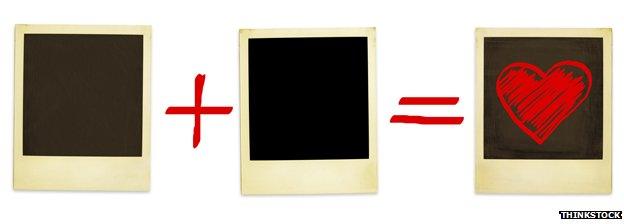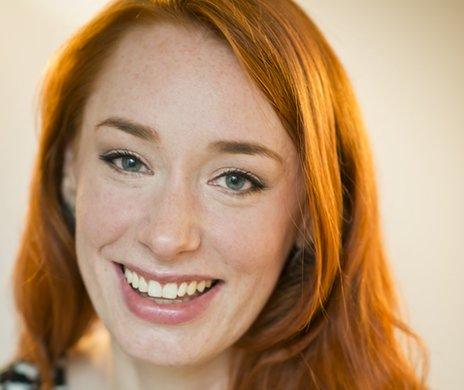The mathematical formula for love
- Published

Looking for the ideal partner? Wondering if your relationship will last? They're common questions as Valentine's Day approaches - so how do you find the right person and keep them? Hannah Fry, author of The Mathematics of Love, says three things make the magic formula.

Be proud: Play up to whatever makes you different
Anyone who's ever joined a dating website will know the hours of agony picking your perfect profile picture - the one where you had perfect hair, glowing skin and a winning smile. Well, you needn't have bothered.
Because being easy on the eye won't give you an easy pass to online success. Instead, having people think you are unattractive can actually work to your advantage.
It may seem counter intuitive, but it's been proven by statistics. Christian Rudder, a mathematician and co-founder of online dating website OKCupid has spent a decade collecting and analysing data from people who use his site.
In one section you can rate how attractive other people are on a scale between 1 and 5. To test how attractiveness might link to popularity, Rudder and his team took a random selection of 5,000 female users and compared the average attractiveness scores they each received with the number of messages they were sent in a month.
You'd think attractiveness would be a pretty good indicator of how popular they'd be. But instead the OKCupid team discovered it was the spread of scores that mattered.
People who divided opinion - those that were rated as both very beautiful and very ugly - did far better than those who everyone agreed were quite cute.

OKCupid's most messaged person, Lauren Urasek, also known as @loandthecosmos
This begins to make sense when you think of things from the perspective of people sending the messages. When you stumble upon someone who is beautiful, but suspect that everyone else will think so too, you imagine they're receiving a lot of messages and decide not humiliate yourself by throwing your hat in the ring.
On the other hand, if you suspect that others may be put off by something quirky in their appearance, there's less competition and an extra incentive to get in touch.
And this gives us our first tip. When most people choose their online dating profile pictures, they tend to try to hide the things that make them unattractive. This is the exact opposite of what you should do.
When choosing a profile picture don't be afraid to put some people off. You're not trying to appeal to the masses, so don't make yourself bland. Play up to whatever makes you different - that's the best way to attract the people who matter.
Indeed, the most messaged person on OKCupid (as of last summer) is Lauren Urasek, external, a makeup artist from Manhattan with striking looks and a 1950s style offset by a number of large, prominent tattoos.
So play up to whatever makes you different. Be proud of that bald patch, show off that tattoo and get that belly out, because standing out online just means being yourself.

Be proactive: Go out and get what you want
Imagine you're at a party with a group of single friends, all trying to decide how best to boost your chances of meeting someone. Should you sit back and wait for them to come to you, or walk right up to the most attractive partygoer, risking a humiliating rejection? And who should you approach to give you the best chance of success?
If we allowed this party scenario to play out in the very old-fashioned boy-approaches-girl way, each of the boys would hit on his first-choice girl. Then, any girl approached by more than one boy can choose between them, leaving the rejected man to move on to his second choice lady.
If nobody wants to leave alone, everyone should find a partner by the end.
The method of one group approaching another follows the rules of the "Gale Shapley Algorithm". And the maths behind this algorithm comes with an important result: those who do the asking will always end up with much better partners than the group who sit back and accept a suitor's advances.
This does make some intuitive sense. If you put yourself out there, start at the top of the list, and work your way down, you'll always end up with the best possible person who'll have you. If you sit around and wait for people to talk to you, you'll end up with the least bad person who approaches you.
Regardless of the type of relationship you're after, it pays to take the initiative.

Be provokable: Speak up if something bothers you
Even people in the best relationships have arguments. But mathematicians have found that the way you argue can reveal your chances of success as a couple.
Over a number of years, psychologist John Gottman recorded hundreds of married couples in conversation with each other, asking them to discuss the most contentious issue in their relationship.
Gottman's team came up with a way to measure, quantify and record everything that transpired - their blood pressure, their skin conductivity and their heart rate, as well as the sentiment of what was actually said.
With just these few measurements, the team could predict whether or not a particular couple was likely to get divorced with up to 90% accuracy.
They found that couples in a good relationship held a deep-seated positive view of one another and the language they used in their arguments reflected that. They would dismiss negative behaviour as out of the ordinary: "She's just tired," or, "They've been really stressed at work recently."
Couples in a relationship that was headed for break-up were the opposite. They held a negative belief and used bad behaviour to reinforce this opinion. "You're always like this," or, "See! You're so selfish."

Hannah Fry

Lecturer in mathematics at the Centre for Advanced Spatial Analysis University College London with particular interest in patterns in human behaviour, particularly in an urban setting
Author of The Mathematics of Love, which was inspired by her TED Talks of the same title

But the insights go beyond mere statistics. Because when Gottman teamed up with mathematician James Murray, they were able to translate their findings into a mathematical model.
The model predicted that it's the spirals of negativity you need to watch out for in a relationship, and particularly something called the "negativity threshold". This is how negative one partner needs to be before provoking a strong reaction in the other.
I always thought that good relationships were about compromise and giving each other room to be yourself - so you might think it was the couples that could let things go (the ones with a high negativity threshold) that did well.
But the team found that the exact opposite was true. It was the couples with the low negativity threshold that had the best chance of staying together in the long run - those who weren't afraid to speak their minds.
These couples continually resolve and repair small issues in their relationship, never letting small things build up to the point where they explode.
So communicate positively, openly and honestly. Who knew maths could give you such a nice way to live?
Listen to More or Less on BBC Radio 4 and the World Service, or download the free podcast.
Subscribe to the BBC News Magazine's email newsletter to get articles sent to your inbox.